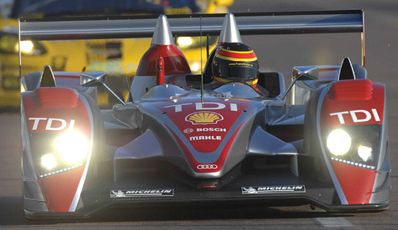
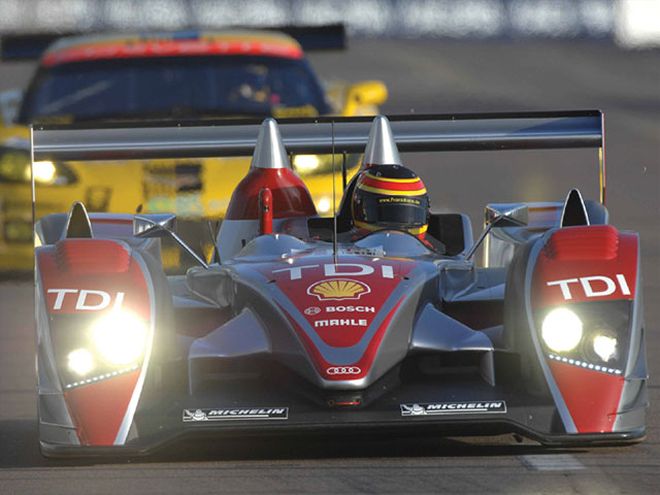 The zero-sulfur diesel powered Audi leads the E85 fueled Corvette in an American Le Mans Series event. This road racing series is at the forefront of alternative fuel motorsports. Courtesy of ALMS
The zero-sulfur diesel powered Audi leads the E85 fueled Corvette in an American Le Mans Series event. This road racing series is at the forefront of alternative fuel motorsports. Courtesy of ALMS
Fossil fuel is dead. There I said it. In the face of stratospheric prices for crude oil (as of this writing one barrel of oil topped $130), one of the political hot buttons nowadays is how fuel prices are affecting the economy and how they are going to affect it in the future.
Americans consume 20-million-barrels of oil every day at a cost of $1.4 billion. That's a lot of oil and a lot of money. We are a little more than two months away from election day when voters will decide who our next president will be. Now both candidates have made energy reform a major portion of their campaigns, and regardless of who gets elected there will be some changes coming. While those changes will affect all of us as American consumers, they also have the potential to affect us as racers as well.
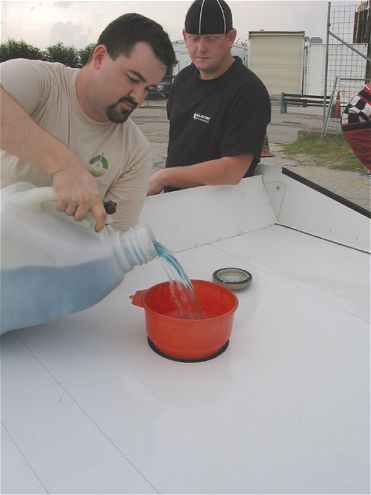 Circle Track's project Dirt Late Model crew member Anthony "Tony" Griffith pours traditional Sunoco 112 race gas into the fuel cell as Derek Powell looks on. Is E85 in our future? Photo by Rob Fisher
Circle Track's project Dirt Late Model crew member Anthony "Tony" Griffith pours traditional Sunoco 112 race gas into the fuel cell as Derek Powell looks on. Is E85 in our future? Photo by Rob Fisher
While hybrid vehicles are gaining popularity (4 out of the 10 best selling cars are hybrids), Detroit is funneling more R&D dollars toward alternative fuel vehicles and, in fact, rumors have popped up recently that say GM will be out of the gasoline engine business within 10 years. At this stage of the game it would be presumptuous for us to try to speculate what and when any real effect on short-track racing will take place. However, we ran across a movement, if we can call it that, which provides an interesting peek into not just the conceptual future of automobile racing but, in actuality, the direction it is headed.
It's really a combined effort between the U.S. Department of Energy (DOE), the U.S. Environmental Protection Agency (EPA), and the Society of Automotive Engineers International (SAE). "It" is called the Green Racing Protocols, and we sat down with Bob Larsen of the Center for Transportation Research at Argonne National Laboratory to find out more.
"The protocols are a way at looking at racing that is different," says Larsen. "What is unique here is that we are focusing on not just racing, but the environmental aspects of racing, or more specifically, making racing sustainable."
Now before you cry foul and think the government is going to make you trade in your 750hp Gaerte for 30 rechargable lithium ion batteries duct taped together, listen to how this movement got started.
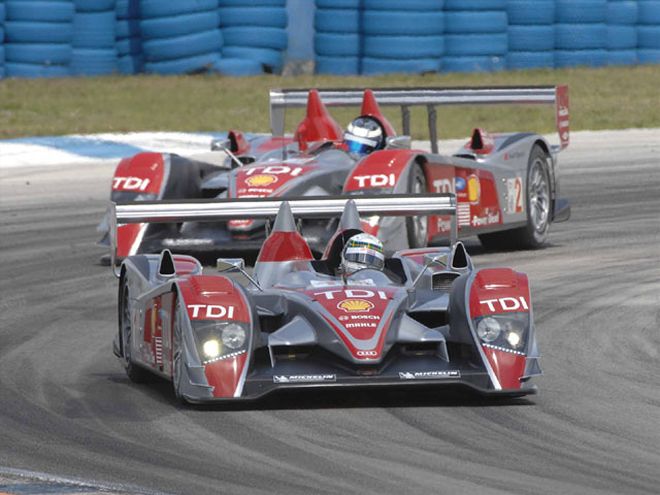 One of the most dominating teams in the 10-year history of the American Le Mans Series, Audi Sport North America, has posted 45 class victories and a record 22 in a row dating back to Sebring in 2006. That was the race that Audi made motorsports history by winning for the first time with the diesel powered Audi R10 TDI, a prototype that represented a new wave of technology into the Series. Using low-sulphur diesel power, Audi Sport North America has captured the three biggest races on the endurance calendar in each of the past two seasons: the Mobil 1 Twelve Hours of Sebring, the 24 Hours of Le Mans, and Petit Le Mans. Courtesy of ALMS
One of the most dominating teams in the 10-year history of the American Le Mans Series, Audi Sport North America, has posted 45 class victories and a record 22 in a row dating back to Sebring in 2006. That was the race that Audi made motorsports history by winning for the first time with the diesel powered Audi R10 TDI, a prototype that represented a new wave of technology into the Series. Using low-sulphur diesel power, Audi Sport North America has captured the three biggest races on the endurance calendar in each of the past two seasons: the Mobil 1 Twelve Hours of Sebring, the 24 Hours of Le Mans, and Petit Le Mans. Courtesy of ALMS
"A little over two years ago at the SAE congress there was a meeting of a new technical working group. People from all over the racing community were at this meeting-tracks, sanctions, suppliers, engine builders, and more. We all agreed that we are likely heading into an era where environmental consciousness, environmental responsibility, and energy issues will become very, very important. A lot of us at this meeting were concerned that racing would get caught up in a wave of negative reaction to the energy issues."
While that initial meeting brought out many excellent points, Larsen and the team started talking about what sustainable racing would mean and how they could structure a set of guidelines or technical recommendations that would contribute to fostering exciting and entertaining racing, while at the same time help drive the new technology soon to come out of the automakers.
They had a secondary plan too; actually use racing as an educational opportunity, essentially preparing the market for the emergence of all these new technologies. They asked themselves the question, in this new era how can we really harness this incredible energy in racing and turn it to a way that it will benefit the country and the world?
In order to develop the solution, the team started at the core of the problem. "Our core notion was that the technology development in racing had grown apart from the technology development in production vehicles," explains Larsen.
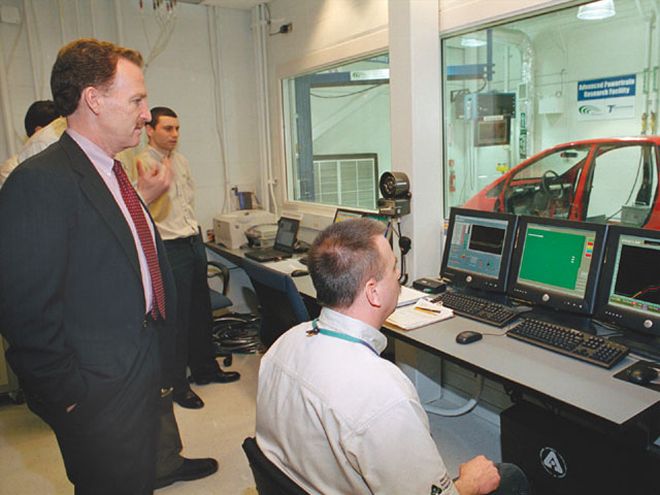 Assistant U.S. Secretary of Energy David Garman (left) watches as Argonne's Advanced Powertrain Test Facility engineers track a car being tested on the dynamometer behind the glass. Courtesy of Argonne National Laboratory
Assistant U.S. Secretary of Energy David Garman (left) watches as Argonne's Advanced Powertrain Test Facility engineers track a car being tested on the dynamometer behind the glass. Courtesy of Argonne National Laboratory
"Racing had always been a way to push the boundaries of technology and that technology would find a path to trickle down to production cars. That is not happening anymore. Today there is a huge gap between what is being done in the R&D labs of the automakers, and what is being developed for the racetrack and that is a little disturbing to us. If we could find a way to unite these resources that would be a really good thing."
The auto industry is going through a transformation that will be extremely painful and is fraught with serious financial risk for the manufacturers. Larsen, a veteran of the industry, says "I know what is going on around the world in the automakers research labs and even in our own (Argonne National Labs) in the area of advanced powertrain development. The systems being developed are absolutely incredible. Great, great stuff but what we have to do here is figure out how to help these guys (the automakers) pull this technology into the marketplace."
Larsen and his team on the aptly named Green Racing Working Group see motorsports as the perfect avenue to accomplish that technology pull-use the racing series to dovetail the development and validation of these new technologies. That concept would be harkening back to the days of Smokey Yunick and the Win on Sunday-Sell on Monday that pushed stock car racing into the limelight.
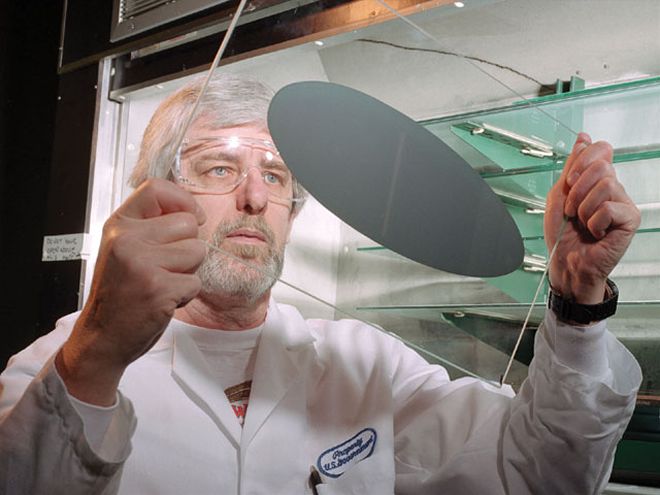 Jack Picciolo holds a sample of the Argonne-developed ceramic membrane material for hydrogen production. Ceramic membranes could supply hydrogen for energy applications, according to Argonne scientist Balu Balachandran, leader of the group developing the new materials. Courtesy of The Argonne National Laboratory
Jack Picciolo holds a sample of the Argonne-developed ceramic membrane material for hydrogen production. Ceramic membranes could supply hydrogen for energy applications, according to Argonne scientist Balu Balachandran, leader of the group developing the new materials. Courtesy of The Argonne National Laboratory
So with an established philosophy in hand and the stated goal of reunifying the technical development between OEM and racers, the team got to work. As we went to press, the group had written a technical paper that contains a series of recommendations or protocols covering the general aspects of their green racing initiative. The protocols spell out a series of guidelines as to what green racing is, yet they tend to be somewhat general in nature. Says Larsen, "we realize that there are so many different forms of motorsports that we couldn't possibly come up with a one size fits all solution."
The Protocols are slated for final balloting in August to become an SAE standard, which means that will have already taken place by the time you read this. Larsen says that there is a high probability that the technical paper will pass the balloting and be published as an industry recommended standard.
Other than the obvious validation by the renowned SAE organization, having an SAE standard focused on procedures for measuring the environmental impact of racing is a testimony to the importance of racing and its integration into the foundation of automotive technology.
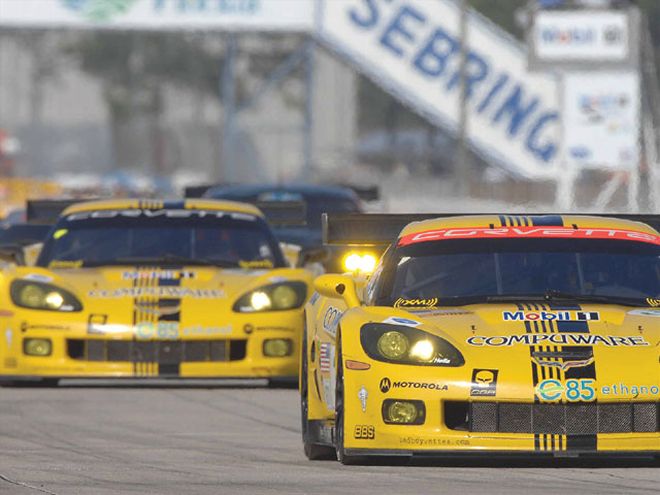 The most successful team in the history of the American Le Mans Series, Corvette Racing's two-car factory effort lead a pioneering effort by campaigning on cellulosic E85. The winner of the last seven GT1 championships, Corvette Racing has posted a record 61 class wins, 44 1-2 team finishes, and swept all 12 rounds in the 2007 season. Courtesy of ALMS
The most successful team in the history of the American Le Mans Series, Corvette Racing's two-car factory effort lead a pioneering effort by campaigning on cellulosic E85. The winner of the last seven GT1 championships, Corvette Racing has posted a record 61 class wins, 44 1-2 team finishes, and swept all 12 rounds in the 2007 season. Courtesy of ALMS
Published standards will especially help form the foundation to achieve the second part of the team's plan; pulling new technology into the marketplace. "Racers and race fans are very passionate, involved people and they tend to be people who talk to other people about what's going on with vehicles," admits Larsen. In some cases, they tend to be first adopters of new technology especially if it makes them go faster and spend less money.
That's a key factor in the success of the auto industry of the future. It won't do any good for OEMs to develop fantastic new technologies for street cars and package them in dull econo-box solutions that lack excitement. While most alternative fuel cars currently fit that bill, Larsen is emphatic that won't be the case in the future. "The thing that all of us involved in the technology realize is that this technology will not lead to dull cars." In a way the marriage of the Green Racing Protocols and motorsports will lead to a resurgence of innovation and development of high performance vehicles at the aftermarket level.
So what exactly are the alternatives? The hybrid is the most commonly known environmentally friendly vehicle on the market. But the plug-in hybrid electric car, where you can plug your car into a standard household electrical outlet, is not far behind.
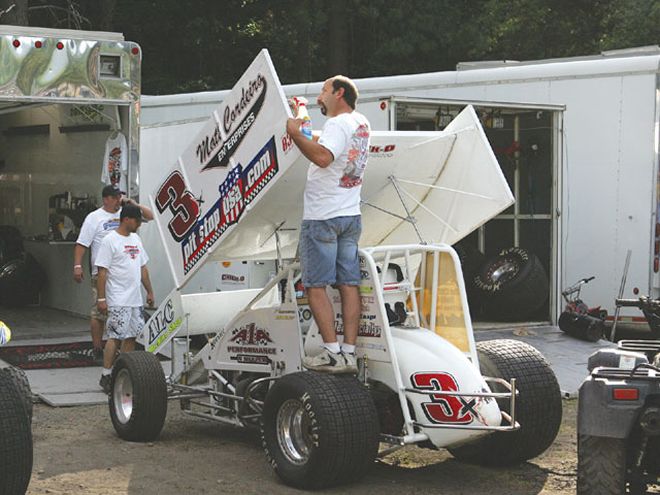 Sprint Cars like this one run on methanol. It's less than a baby step to 100 percent environmentally friendly cellulosic ethanol. Courtesy of stevesracingphotos.com
Sprint Cars like this one run on methanol. It's less than a baby step to 100 percent environmentally friendly cellulosic ethanol. Courtesy of stevesracingphotos.com
Beyond hybrids and electrics, there are fuel alternatives in more traditional internal combustion engines such as zero-sulfur or "clean" diesel, E10 (which you can buy at many gas stations today), Ethanol (which can be manufactured from a variety of homegrown grains such as sugar), E85 cellulosic Ethanol (which is made from non-food fibers such as algae, lumber industry waste, etc.), and more.
Then there is a whole series of new technologies on the horizon such as something called a regenerative energy recovery system. In a nutshell, you would have an onboard system that would capture and store dissipated energy from a specific vehicle function, braking for example. That energy could then be tapped into by the driver in an on-demand capacity. Larsen explains that concept in terms of racing by saying, "Imagine if you had a push to pass button. You could decide when and where to use the stored energy based on track position, number of laps completed, and so on. Perhaps you are drafting down a straightaway behind somebody, hit the button, and you pull out and blast by the guy. Or maybe you use it to accelerate by somebody coming out of a key corner."
While the concept of a regenerative energy recovery system adds another layer of strategy to racing, it is just one example of the type of exciting green technology that can find its way into motorsports.
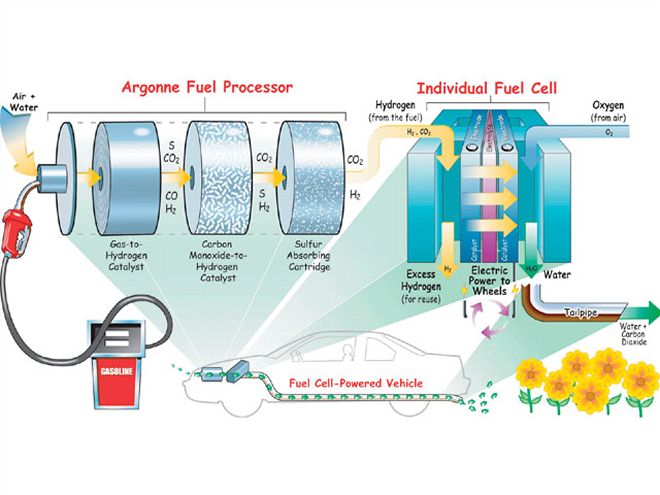 Argonne's fuel processor turns petroleum-based fuels, such as gasoline, into hydrogen plus carbon monoxide and carbon dioxide. The carbon monoxide is then converted into additional hydrogen plus sulfur and carbon dioxide and the sulfur is removed, leaving only traces of carbon dioxide and hydrogen. The hydrogen powers each of several fuel cells, which make electricity to power the vehicle. The emissions are carbon dioxide and a small amount of water. Courtesy of Argonne National Laboratory
Argonne's fuel processor turns petroleum-based fuels, such as gasoline, into hydrogen plus carbon monoxide and carbon dioxide. The carbon monoxide is then converted into additional hydrogen plus sulfur and carbon dioxide and the sulfur is removed, leaving only traces of carbon dioxide and hydrogen. The hydrogen powers each of several fuel cells, which make electricity to power the vehicle. The emissions are carbon dioxide and a small amount of water. Courtesy of Argonne National Laboratory
The IndyCar Series made PR waves when they introduced their alternative racing fuel push with their exclusive E85 deal. But beyond the admirable efforts of Indy, the American Le Mans Series (ALMS) were the ones who gained the initial look from the team. "The folks at IMSA and ALMS have been the biggest supporters of our efforts," says Larsen of the Georgia based road racing sanction. Since their inception, ALMS has had a technical rule book that not only allows, but encourages, manufacturers to develop cutting-edge innovations, such as alternative automotive fuels. That made them a perfect fit for what Larsen and the team were trying to accomplish.
"The series has always embraced technical development, and it's not just the manufacturer supported teams. We have independent teams who are bringing their own technologies," says Scott Atherton, president and CEO of ALMS. "There was a time not long ago when we weren't going to a spec tire, a spec chassis, or a spec fuel. People predicted that to be our downfall. In somewhat of an ironic turn the industry is now coming to us."
In addition to E10, ALMS currently lists E85 (a cellulosic ethanol made from 100 percent wood waste) as well as zero-sulfur clean diesel as alterative fuels currently in use in competition. "The reason we chose these fuels is that we believe that they represent the fuel station of the future. These will be the three choices consumers will see at the pump."
Racing with alternative fuels and alternative powertrains, such as direct injection motors, has not had an adverse impact on the racing that ALMS puts on the track, quite the opposite actually. "We've demonstrated that you can race just as competitively, just as exciting, just as entertaining, but do it in more of an environmentally friendly way," says Atherton. "If you can achieve that, then why wouldn't you? That's something we're very proud to be leaders in, but I don't expect to be the only one for very long."
Atherton is emphatic that while ALMS is working with the government on the Green Racing Protocols, it by no means is an exclusive relationship. The EPA and DOE are both actively lobbying other racing sanctioning bodies to follow ALMS' lead. And that's where the root of this movement has to begin-at the sanctioning body level.
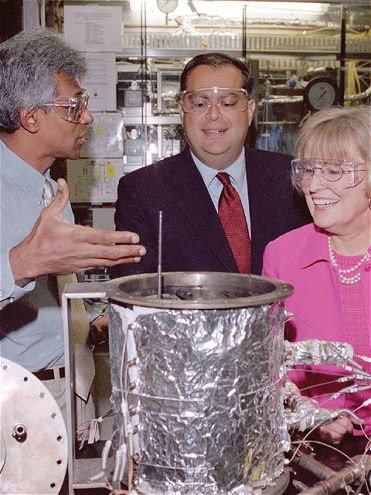 This Argonne-developed reformer releases hydrogen from commonly available fuels to power fuel cells in cars. Argonne's Shabbir Ahmed (left) explains the reformer to U.S. Secretary of Energy Spencer Abraham and U.S. Rep. Judy Biggert, R-Ill. Courtesy of Argonne National Laboratory
This Argonne-developed reformer releases hydrogen from commonly available fuels to power fuel cells in cars. Argonne's Shabbir Ahmed (left) explains the reformer to U.S. Secretary of Energy Spencer Abraham and U.S. Rep. Judy Biggert, R-Ill. Courtesy of Argonne National Laboratory
Some of the initiatives the sanction has taken has garnered it a lot of publicity in the recent weeks. Their Green Challenge Award will be presented in both the Prototype and Grand Touring classes for the first time at the Petit Le Mans on October 4, 2008. This Le Mans-qualifying race was selected for the debut of this major new award as a way to announce and promote a season-long Green Challenge Championship during the 2009 ALMS season. Presented by senior officials from the DOE, EPA, and SAE International, the Award will go to the manufacturer that demonstrates technology that enables their racing vehicle to go the furthest, the fastest, with the smallest environmental footprint for the energy used.
"More than anything else we've done, that announcement has captured the general media's interest like nothing else," says Atherton. And that's really good for motorsports in general.
The Green Racing Protocols are much more than just putting unrestricted road racing cars that run on renewable energy on a track. Sure promoting these renewable fuels as a cornerstone of motorsports has many good implications for our country and the world, but the Protocols look at these technologies from a wells to wheels life cycle. That concept is foreign to people who haven't been around energy policy, but simply put it addresses all aspects of the energy and emissions embodied in the fuel such as discovery of the fuel resource, its extraction, processing, emissions from processed fuel, and more.
For example, methanol is certainly a better fuel option than gas, but much of the methanol produced today comes from natural gas, which is a fossil fuel, so how environmentally friendly is that?
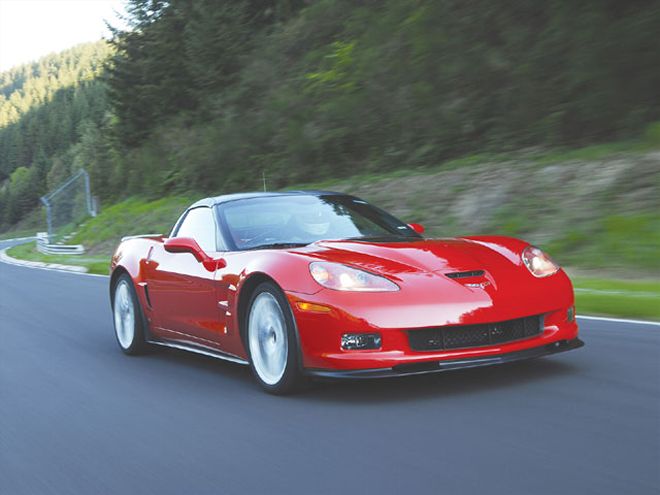 It's only a matter of time before a major auto manufacturer puts out a high performance hybrid. Could this be it? Courtesy of General Motors
It's only a matter of time before a major auto manufacturer puts out a high performance hybrid. Could this be it? Courtesy of General Motors
The Green Racing Protocols factor in that upstream impact and even looks at the facilities and event management of the process. So it is a complete picture philosophy of marrying future technology with motorsports.
That is a pretty tall order and will certainly take time and a lot of hard work among a lot of people from different walks of life. But it has to happen.
"If any form of motorsports chooses to ignore the realities of the environment that is surrounding us now, it'll only be a matter of time before they are held accountable," says Atherton.
How you factor hybrids, alternative fuels, and new powertrain technologies into a racing series without upsetting the balance is the real trick. But short-track racers have a very real, very easy option to join this movement. E85, the ethanol product ALMS uses, is derived 100 percent from wood waste (think sawdust on the floor of a lumber mill). It's a relatively straightforward technical switch from methanol and even gas to E85. If a major sanction, or even a regional one, pushed for and then publicized a change to E85 the benefits could be huge.
The bottom line is that we need to think about replacing our dependence on fossil fuels both in passenger cars and at the racetrack. The question is which short-track sanction is going to follow ALMS' lead?